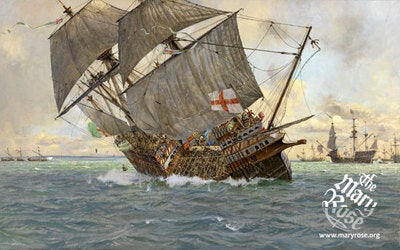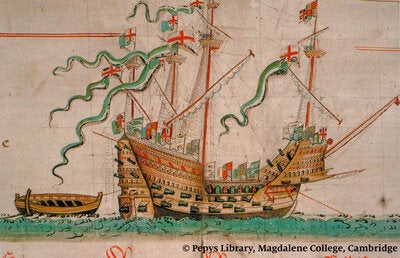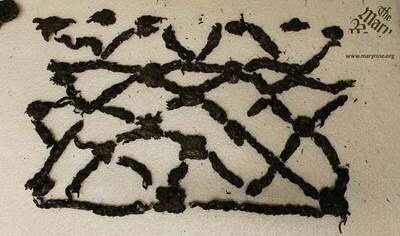
When the Mary Rose sank in July 1545, 470 years ago this month, she took with her over 500 men, ranging from the yonkers and gromets who did the odd jobs around the ship, to her commander, Vice Admiral George Carew. But why did so many men drown?
The Mary Rose wasn't alone; there were over a hundred English ships not far behind her, and even the French could have picked up crewmen to take as prisoners, yet accounts from the time only list between 30-40 survivors. Even the Cowdray Engraving, a contemporary illustration of the event, shows small boats going out to rescue survivors, so why weren't there more.
One reason that gets passed around a lot is that the crew couldn't swim. To many people, this seems odd; working around water, you'd think that you'd be sure to make the effort to try and survive should they fall in.
There is a myth about why sailors couldn't swim, claiming that they felt that drowning was a quicker, 'nicer' death than starvation, which might happen before help could arrive. What's worth remembering, though, is that while swimming is a popular leisure activity today, it wasn't the case in the 1500s. Seaside holidays wouldn't come in for another 300 years, and there were no swimming pools. Lakes and rivers were just places to get water from, so most people never learned to swim for the same reason most people today don't learn first aid - you'll very rarely need to do it, so let's just not think about it, and hope someone else is around to save you.

Even if they could swim, what the crew wore was against them. The majority of the crew wore wool, which has a tendency to get very heavy, very quickly, when wet. This is probably why accidental drownings were so common during the Tudor period, as the added weight, combined with the effort required to move while fully dressed in water, will overcome all but the strongest swimmers. When you consider that many of the soldiers on the Mary Rose would also have been wearing armour, both plate and mail, you can see why they didn't just tread water until help came.
Ultimately, though, the thing that caused the deaths of the Mary Rose's crew was, rather ironically, a safety feature. During the early days of naval warfare, the aim of combat wasn't to sink ships, but to capture them. This had benefits - They lost a ship, but you gained one, plus you had all their contents and plenty of prisoners to sell back. To prevent this, ships like the Mary Rose were fitted with anti-boarding netting, which was stretched above the top of the upper decks like a tent, giving the crew room to walk about. The netting was coated in pitch, to prevent damage from seawater, which would also on occasion be mixed with sand to make it harder it cut through. While the boarder was trying to cut though, the crew would be underneath, shooting at them with arrows, jabbing at them with pikes and generally making things very unpleasant for the intruder.

A surviving fragment of anti-boarding net, recovered from the Mary Rose.
Sadly, while it was very good at keeping people out, it also kept people in. There were no quick-release features that modern health and safety rules would demand, so once the ship began to sink there was no easy way out. Only those who happened to be near an access point or were in the rigging above the netting, would have been able to escape.
Modern Health and Safety regulations are often maligned, criticised as being intrusive and patronising, but had they existed in 1545, there might have been a lot more survivors. So, next time you're on a ferry or an aeroplane, and the safety demonstration starts, maybe you should pay attention, it'll save your life.
